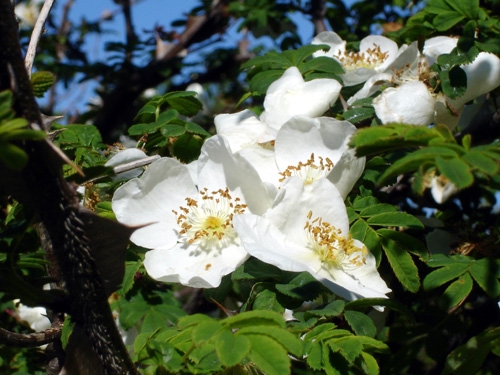Silky Rose
(Rosa sericea)
Silky Rose (Rosa sericea)
/
/

Ulf Eliasson epibase
CC BY 2.5
Image By:
Ulf Eliasson epibase
Recorded By:
Copyright:
CC BY 2.5
Copyright Notice:
Photo by: Ulf Eliasson epibase | License Type: CC BY 2.5 | License URL: https://creativecommons.org/licenses/by/2.5 | Uploader: Epibase | Publisher: Wikimedia Commons | Title: Rosa_sericea_Pteracantha1UME.jpg | Notes: |



























Estimated Native Range
Summary
Rosa sericea, commonly known as Silky Rose, is a deciduous shrub native to the open woodlands and forest edges of South and Southeast Asia, particularly in the Himalayas and western China. It typically grows to a height of 2 meters (6+1⁄2 feet) and is noted for its dense, spiny stems. The Silky Rose blooms in spring and summer, producing flowers that range in color from cream to yellow and white. These blossoms are modest in size and not particularly showy, but they are valued for their delicate appearance and fragrance. The plant’s foliage is also of interest, with pinnate leaves that have a soft, silky texture.
The Silky Rose is appreciated in cultivation for its unique ornamental qualities, including its striking red thorns, especially prominent in the variety Rosa sericea f. pteracantha. It is used in gardens for border planting, as a specimen shrub, and for its potential to create natural barriers due to its spiny nature. This rose prefers full sun but can tolerate part shade and requires medium amounts of water. It is adaptable to a range of soil types, provided they offer good drainage. While it is generally easy to maintain, it can be susceptible to common rose diseases such as black spot and powdery mildew. Gardeners should also be aware of its sharp thorns when planting and maintaining this shrub.CC BY-SA 4.0
The Silky Rose is appreciated in cultivation for its unique ornamental qualities, including its striking red thorns, especially prominent in the variety Rosa sericea f. pteracantha. It is used in gardens for border planting, as a specimen shrub, and for its potential to create natural barriers due to its spiny nature. This rose prefers full sun but can tolerate part shade and requires medium amounts of water. It is adaptable to a range of soil types, provided they offer good drainage. While it is generally easy to maintain, it can be susceptible to common rose diseases such as black spot and powdery mildew. Gardeners should also be aware of its sharp thorns when planting and maintaining this shrub.CC BY-SA 4.0
Plant Description
- Plant Type: Shrub
- Height: 6-8 feet
- Width: 5-7 feet
- Growth Rate: Moderate
- Flower Color: Cream, Yellow, White
- Flowering Season: Spring, Summer
- Leaf Retention: Deciduous
Growth Requirements
- Sun: Full Sun
- Water: Medium
- Drainage: Slow, Medium, Fast
Common Uses
Bee Garden, Bird Garden, Butterfly Garden, Deer Resistant, Drought Tolerant, Edible*Disclaimer: Easyscape's listed plant edibility is for informational use. Always verify the safety and proper identification of any plant before consumption., Fragrant
Natural Habitat
Open woodlands and forest edges
Other Names
Common Names: Mount Omei Rose, Himalayan Rose, Seiden-Rose, Juan Mao Qiang Wei
Scientific Names: , Rosa sericea, Rosa sericea f. glabrescens, Rosa sericea f. glandulosa, Rosa sericea f. chrysocarpa, Rosa sericea f. sericea, Rosa tetrapetala, Rosa wallichii,
GBIF Accepted Name: Rosa sericea Lindl.